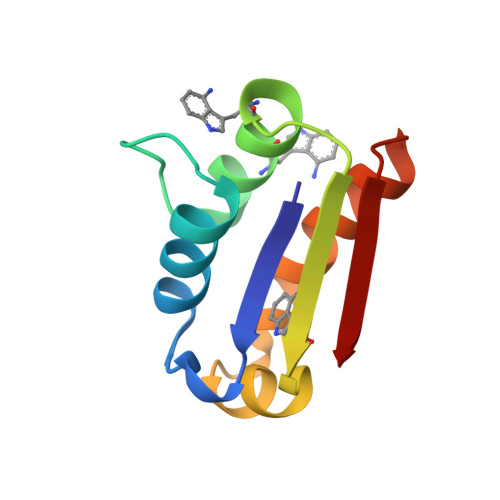Aminotryptophan-containing barstar
Rubini, M., Lepthien, S., Golbik, R., Budisa, N.(2006) Biochim Biophys Acta 1764: 1147-1158
- PubMed: 16782415
- DOI: https://doi.org/10.1016/j.bbapap.2006.04.012
- Primary Citation of Related Structures:
2HXX - PubMed Abstract:
The indole ring of the canonical amino acid tryptophan (Trp) possesses distinguished features, such as sterical bulk, hydrophobicity and the nitrogen atom which is capable of acting as a hydrogen bond donor. The introduction of an amino group into the indole moiety of Trp yields the structural analogs 4-aminotryptophan ((4-NH(2))Trp) and 5-aminotryptophan ((5-NH(2))Trp). Their hydrophobicity and spectral properties are substantially different when compared to those of Trp. They resemble the purine bases of DNA and share their capacity for pH-sensitive intramolecular charge transfer. The Trp --> aminotryptophan substitution in proteins during ribosomal translation is expected to result in related protein variants that acquire these features. These expectations have been fulfilled by incorporating (4-NH(2))Trp and (5-NH(2))Trp into barstar, an intracellular inhibitor of the ribonuclease barnase from Bacillus amyloliquefaciens. The crystal structure of (4-NH(2))Trp-barstar is similar to that of the parent protein, whereas its spectral and thermodynamic behavior is found to be remarkably different. The T(m) value of (4-NH(2))Trp- and (5-NH(2))Trp-barstar is lowered by about 20 degrees Celsius, and they exhibit a strongly reduced unfolding cooperativity and substantial loss of free energy in folding. Furthermore, folding kinetic study of (4-NH(2))Trp-barstar revealed that the denatured state is even preferred over native one. The combination of structural and thermodynamic analyses clearly shows how structures of substituted barstar display a typical structure-function tradeoff: the acquirement of unique pH-sensitive charge transfer as a novel function is achieved at the expense of protein stability. These findings provide a new insight into the evolution of the amino acid repertoire of the universal genetic code and highlight possible problems regarding protein engineering and design by using an expanded genetic code.
Organizational Affiliation:
Max-Planck-Institut für Biochemie, Am Klopferspitz 18, D-82152 Martinsried, Germany.















